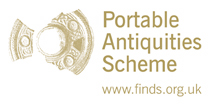File:Early Medieval possible Bone Skate (FindID 878116).jpg

Original file (3,543 × 2,753 pixels, file size: 670 KB, MIME type: image/jpeg)
Captions
Captions
Summary
[edit]| Early Medieval possible Bone Skate | |||
|---|---|---|---|
| Photographer |
North Lincolnshire Museum, Martin Foreman, 2017-12-01 16:12:07 |
||
| Title |
Early Medieval possible Bone Skate |
||
| Description |
English: Bone possible skate fragment. A large mammal long bone, probably cannon bone of horse, with a hole of diameter 11.7mm drilled from the posterior aspect immediately below the facets of the articular surface so as to meet the natural longitudinal cavity in the middle of the bone, and breaking out at the other side. Butchery marks appear as angled cuts close to the end of the bone. The facets of the articular surface are abraded, and some bone has been lost around the drilled hole. Angled chopping has trimmed the posterior surface with at least two hefty blows, resulting in or contributing to the fracture of the bone at its mid-shaft, leaving a jagged point.
The perforation of this robust bone is a feature of objects made from the same material and identified as bone skates (Macgregor 1985, pages 141-144). The hole would enable a peg to be inserted to secure ankle lashings. The trimming of the posterior surface may have been intended to afford purchase to the skater's foot, while the flatter natural configuration of the other, anterior, side of the bone lent itself to smooth movement over ice, and could be exaggerated and polished by subsequent wear. The use of such skates extends back to the Bronze Age, is widely recorded in early medieval contexts in Europe, and in Britain is known up to the 13th century. There is little or no wear on the anterior surface of the bone, suggesting the object saw scant use, or even that it was broken while being made. Suggested date: Early Medieval to Medieval, 850-1300. Length: 170mm, Width: 42.5mm, Thickness: 32.6mm, Weight: 120.29gms |
||
| Depicted place | (County of findspot) North Lincolnshire | ||
| Date | between 850 and 1300 | ||
| Accession number |
FindID: 878116 Old ref: NLM-166FF4 Filename: NLM38114.jpg |
||
| Credit line |
|
||
| Source |
https://finds.org.uk/database/ajax/download/id/639713 Catalog: https://finds.org.uk/database/images/image/id/639713/recordtype/artefacts archive copy at the Wayback Machine Artefact: https://finds.org.uk/database/artefacts/record/id/878116 |
||
| Permission (Reusing this file) |
Attribution License version 2.0 (verified 3 December 2020) | ||
Licensing
[edit]- You are free:
- to share – to copy, distribute and transmit the work
- to remix – to adapt the work
- Under the following conditions:
- attribution – You must give appropriate credit, provide a link to the license, and indicate if changes were made. You may do so in any reasonable manner, but not in any way that suggests the licensor endorses you or your use.
File history
Click on a date/time to view the file as it appeared at that time.
| Date/Time | Thumbnail | Dimensions | User | Comment | |
|---|---|---|---|---|---|
| current | 13:17, 6 December 2018 |  | 3,543 × 2,753 (670 KB) | Fæ (talk | contribs) | Portable Antiquities Scheme, NLM, FindID: 878116, early medieval, page 523, batch count 9120 |
You cannot overwrite this file.
File usage on Commons
The following page uses this file:
Metadata
This file contains additional information such as Exif metadata which may have been added by the digital camera, scanner, or software program used to create or digitize it. If the file has been modified from its original state, some details such as the timestamp may not fully reflect those of the original file. The timestamp is only as accurate as the clock in the camera, and it may be completely wrong.
| Orientation | Normal |
|---|---|
| Horizontal resolution | 300 dpi |
| Vertical resolution | 300 dpi |
| Software used | Adobe Photoshop Elements 10.0 Windows |
| File change date and time | 15:50, 1 December 2017 |
| Color space | sRGB |
| Image width | 3,543 px |
| Image height | 2,753 px |
| Date and time of digitizing | 15:50, 1 December 2017 |
| Date metadata was last modified | 15:50, 1 December 2017 |
| Unique ID of original document | xmp.did:6F54F5E2ABD6E711A300913DE30B5791 |
